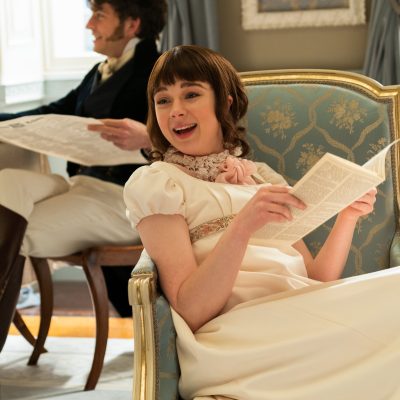Romance media is awash with cringe-making cultural stereotypes, writes Bomi Park
Support independent, non-corporate media.
Donate here!

“My type’s Ryan Reynolds from La La Land.” “My type’s Mamura-kun from Daytime Shooting Star.” This is what my friends bring up as their ideal type of man when talking about love and relationships – fictional characters. Scroll through the top ten most-watched shows on Netflix and you’ll find a variety of Western or Asian teenage romance films. Why are people so obsessed with these genres when pursuing these dreamy male/female archetypes only perpetuates cultural stereotypes?
The numbers prove that romance is popular. The Global Webtoon Market is expected to grow to 45.30 billion USD by 2030, with the romance-fantasy/fiction segment seeing the most significant leap in profitability. For example, the “new girl in town” storyline often revolves around a girl moving to a new town and school, where she becomes entangled in a romantic storyline involving multiple boys. These boys typically embody the idealised traits of a schoolboy, reflecting the cultural standards of male charm in the country producing the show.
This predictable structure has contributed to the growth of romance media’s multicultural popularity, leading to distinct styles and divisions: K-drama, Japanese school romance, Chinese fantasy, British Regency romance and so on (and on). The immersive settings and characters create an escape from reality, providing the viewer with an indirect experience of cross-cultural romance. British Regency couples emphasise nobility and styles associated with English wit, humour, and sarcasm, unfamiliar to countries in the East. Seeing these dramas up close is a new experience. K-drama couples, on the other hand, often pace their love progression tediously, with the last episode ending in a single kiss, no more. The emotional development and the rather dramatic obstacles that somehow postpone the characters’ love achievements bubble in a new stream of romance clichés.
This has blurred the line between reality and fiction.
“My type’s Ryan Reynolds from La La Land.” “My type’s Mamura-kun from Daytime Shooting Star.” This is what my friends bring up as their ideal type of man when talking about love and relationships – fictional characters. Scroll through the top ten most-watched shows on Netflix and you’ll find a variety of Western or Asian teenage romance films. Why are people so obsessed with these genres when pursuing these dreamy male/female archetypes only perpetuates cultural stereotypes?
The numbers prove that romance is popular. The Global Webtoon Market is expected to grow to 45.30 billion USD by 2030, with the romance-fantasy/fiction segment seeing the most significant leap in profitability. For example, the “new girl in town” storyline often revolves around a girl moving to a new town and school, where she becomes entangled in a romantic storyline involving multiple boys. These boys typically embody the idealised traits of a schoolboy, reflecting the cultural standards of male charm in the country producing the show.
This predictable structure has contributed to the growth of romance media’s multicultural popularity, leading to distinct styles and divisions: K-drama, Japanese school romance, Chinese fantasy, British Regency romance and so on (and on). The immersive settings and characters create an escape from reality, providing the viewer with an indirect experience of cross-cultural romance. British Regency couples emphasise nobility and styles associated with English wit, humour, and sarcasm, unfamiliar to countries in the East. Seeing these dramas up close is a new experience. K-drama couples, on the other hand, often pace their love progression tediously, with the last episode ending in a single kiss, no more. The emotional development and the rather dramatic obstacles that somehow postpone the characters’ love achievements bubble in a new stream of romance clichés.
This has blurred the line between reality and fiction. Audiences are no longer reminded that they are observers, but rather find themselves absorbed into this manipulated superficiality. The risk is that this can lead to assumptions and mistaken beliefs, especially toward other cultures. These countless medias producing sub-cultural romance fiction have the detrimental effect of delusion; distortion through the application of a made-up setting of the real world, and creating prejudice from assuming the demeanour of universal ethnicities.
A prom example of this could be seen in the Netflix original TV series XO, Kitty, released in 2023. It debuted as #2 on the English TV list and was in the top 10 in over 90 countries. The story follows a girl named Kitty Song Covey from Oregon, who moves to South Korea, enrolling at KISS International School to find her true love. From its popularity, I noticed many people wanting to tour my country — dreaming of finding a handsome Korean boyfriend. As a genuine Korean, I find this delusional. Visiting the country is fine, but the problem arises in romanticising Korea based on expectations derived from this series. A multicultural media platform shared globally is a significant step toward promoting cultural exchange. However, overly dramatic settings and unrealistic incidents that are portrayed as leading to happy endings or being morally acceptable can mistakenly beguile viewers, shaping a flawed perception of the represented country.
For example, Kitty Song Covey is highly overwhelmed about moving to a new school and nearly causes an accident by almost stepping into traffic without paying attention. Although she not injured, she asks strangers in a passing car “can I get a ride?” while still stumbling in the traffic. This behaviour only leaves the viewers baffled. Kitty’s attempt to cross the street without looking on both the sides of the traffic to see if cars were coming showed disregard for others. That the passengers in the car actually accepts her request, and doesn’t seem to be offended, which is the last thing the citizens of Seoul could do, stretches credulity too far. But wait, it gets worse! The passenger later turns out to be a student, Yuri, at KISS; this only makes his character a fool, no matter the intention was to show the ‘neighborhoody’ benevolence of Koreans.
In the series, Yuri ultimately allows Kitty to ride in her car. However, in Korean cultural terms, this behaviour is considered morally rude and irresponsible. The proper course of action would be to call the police or, if injured, seek medical attention at a hospital. Hitchhiking or riding in someone else’s car is highly unusual in Korea, where individualism and respect for private property are prioritised.
The stories in XO, Kitty don’t represent even a fraction of our homogeneous population and culture. I graduated from an international school in South Korea, and I once thought things might be magical. But it wasn’t filled with drama; it was simply another demanding academic pursuit. Fancy parties and students wearing luxury brands and stilettos to school are unusual — of course — and any real-life romance with a ‘Korean’ is not like you dreams of. Playboys and hook-ups are rare, and not all relationships, especially during adolescence, are for the romantic-seeking dramaramas Kitty admires: the soft kissing, emotional confessions, dramatic confrontations, and love triangles. The film features a lot of scenes with couples making out inside school, in common space which is inappropriate, showing passionate, aggressive love. But the couples in my school were either very timid, respecting each other’s life goals. They weren’t eager to prove their love in public or to create drama, because comfort and emotional care was what they centred around. Any drama like Kitty, Min-ho, Yuri, and Dae-Heon would only imperil their academic progress.
School is tough. Every student will be so very busy and won’t even try to interact — certainly that was me. The only topics we chatted about were work and tests. In XO, Kitty, Korean culture is a little realistic, but it’s also romanticized and manipulated in the name of fiction. After thousands watch it, statements like “I like Korean boys” flood social media comments and threads, and viewers begin to base their “type” on a fictional character.
Another example is the European dream cliche in the Netflix show Emily in Paris. The series last year released its fourth season, which ranked second on the English TV List the week of August 19. If you somehow missed it, Emily is an American woman who moves to Paris for a job, but as the story develops, the focus on Emily’s character growth shifts to how many French men she falls in love with.
Besides the switch of plot line to only following Emily’s romantic growth rather than her career, the series exaggerates the leisurely aspects of French culture to the point of languidness. Jenny, a 31 year old Parisian journalist criticized the show, saying that the representation of ‘lazy’ work-life of French people is “totally wrong.”
These generalisations depicted through people smoking and drinking during work, reinforces the stereotypes that the French prefer indulgence over professionalism. French author and actor Fabien Cornibeau expressed his disdain for the production, stating, “Emily in Paris is only for visual pleasure … the Americans living in France hate it the most. This is an American production made for Americans.” The series also is notorious for its brazen product placement, where luxury brands and high-end items are prominently featured to appeal to international audiences. This overemphasis on consumerism detracts from an authentic portrayal of French culture, reducing it to a commercialised fantasy built around aesthetics and materialism. Such portrayals not only misrepresent French society but also perpetuate superficial impressions of Parisian life.
While it has the power to bridge audiences and share cultures, multicultural media needs to walk a thin line so as not to distort realities in the interest of drama and spectacle. The fictional love stories may set dreams alight, but they should not be the lens through which whole cultures are viewed. As viewers, we owe it to ourselves and to the cultures represented to know the difference between fantasy and reality, and appreciate story without losing sight of truth.
The risk is that this can lead to assumptions and mistaken beliefs, especially toward other cultures. These countless medias producing sub-cultural romance fiction have the detrimental effect of delusion; distortion through the application of a made-up setting of the real world, and creating prejudice from assuming the demeanour of universal ethnicities.
A prime example of this could be seen in the Netflix original TV series XO, Kitty, released in 2023. It debuted as #2 on the English TV list and was in the top 10 in over 90 countries. The story follows a girl named Kitty Song Covey from Oregon, who moves to South Korea, enrolling at KISS International School to find her true love. From its popularity, I noticed many people wanting to tour my country — dreaming of finding a handsome Korean boyfriend. As a genuine Korean, I find this delusional. Visiting the country is fine, but the problem arises in romanticising Korea based on expectations derived from this series. A multicultural media platform shared globally is a significant step toward promoting cultural exchange. However, overly dramatic settings and unrealistic incidents that are portrayed as leading to happy endings or being morally acceptable can mistakenly beguile viewers, shaping a flawed perception of the represented country.
For example, Kitty Song Covey is highly overwhelmed about moving to a new school and nearly causes an accident by almost stepping into traffic without paying attention. Although she not injured, she asks strangers in a passing car “can I get a ride?” while still stumbling in the traffic. This behaviour only leaves the viewers baffled. Kitty’s attempt to cross the street without looking on both the sides of the traffic to see if cars were coming showed disregard for others. That the passengers in the car actually accepts her request, and doesn’t seem to be offended, which is the last thing the citizens of Seoul could do, stretches credulity too far. But wait, it gets worse! The passenger later turns out to be a student, Yuri, at KISS; this only makes his character a fool, no matter the intention was to show the ‘neighborhoody’ benevolence of Koreans.
In the series, Yuri ultimately allows Kitty to ride in her car. However, in Korean cultural terms, this behaviour is considered morally rude and irresponsible. The proper course of action would be to call the police or, if injured, seek medical attention at a hospital. Hitchhiking or riding in someone else’s car is highly unusual in Korea, where individualism and respect for private property are prioritised.
The stories in XO, Kitty don’t represent even a fraction of our homogeneous population and culture. I graduated from an international school in South Korea, and I once thought things might be magical. But it wasn’t filled with drama; it was simply another demanding academic pursuit. Fancy parties and students wearing luxury brands and stilettos to school are unusual — of course — and any real-life romance with a ‘Korean’ is not like you dreams of. Playboys and hook-ups are rare, and not all relationships, especially during adolescence, are for the romantic-seeking dramaramas Kitty admires: the soft kissing, emotional confessions, dramatic confrontations, and love triangles. The film features a lot of scenes with couples making out inside school, in common space which is inappropriate, showing passionate, aggressive love. But the couples in my school were either very timid, respecting each other’s life goals. They weren’t eager to prove their love in public or to create drama, because comfort and emotional care was what they centred around. Any drama like Kitty, Min-ho, Yuri, and Dae-Heon would only imperil their academic progress.
School is tough. Every student will be so very busy and won’t even try to interact — certainly that was me. The only topics we chatted about were work and tests. In XO, Kitty, Korean culture is a little realistic, but it’s also romanticized and manipulated in the name of fiction. After thousands watch it, statements like “I like Korean boys” flood social media comments and threads, and viewers begin to base their “type” on a fictional character.
Another example is the European dream cliche in the Netflix show Emily in Paris. The series last year released its fourth season, which ranked second on the English TV List the week of August 19. If you somehow missed it, Emily is an American woman who moves to Paris for a job, but as the story develops, the focus on Emily’s character growth shifts to how many French men she falls in love with.
Besides the switch of plot line to only following Emily’s romantic growth rather than her career, the series exaggerates the leisurely aspects of French culture to the point of languidness. Jenny, a 31 year old Parisian journalist criticized the show, saying that the representation of ‘lazy’ work-life of French people is “totally wrong.”
These generalisations depicted through people smoking and drinking during work, reinforces the stereotypes that the French prefer indulgence over professionalism. French author and actor Fabien Cornibeau expressed his disdain for the production, stating, “Emily in Paris is only for visual pleasure … the Americans living in France hate it the most. This is an American production made for Americans.” The series also is notorious for its brazen product placement, where luxury brands and high-end items are prominently featured to appeal to international audiences. This overemphasis on consumerism detracts from an authentic portrayal of French culture, reducing it to a commercialised fantasy built around aesthetics and materialism. Such portrayals not only misrepresent French society but also perpetuate superficial impressions of Parisian life.
While it has the power to bridge audiences and share cultures, multicultural media needs to walk a thin line so as not to distort realities in the interest of drama and spectacle. The fictional love stories may set dreams alight, but they should not be the lens through which whole cultures are viewed. As viewers, we owe it to ourselves and to the cultures represented to know the difference between fantasy and reality, and appreciate story without losing sight of truth.









